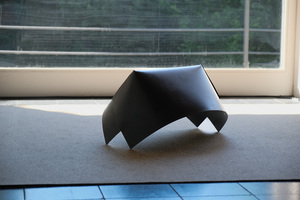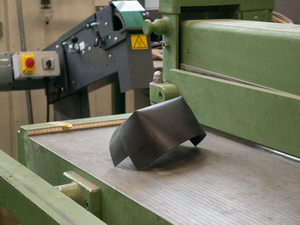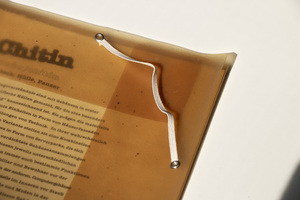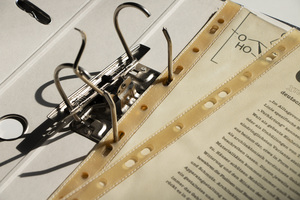"Druckerzeugnisse der HfG"
| Begriff | Druckerzeugnisse der HfG |
| Metakey | Freigabe Nutzung HfG (rights:usage_hfg) |
| Typ | Keyword |
| Vokabular | Rechte |
1526 Inhalte
- Seite 1 von 128
Folded Sheets/ Shell
- Titel
- Folded Sheets/ Shell
- Autor/in
- Schlagworte
- Datierung
- 2025
- Titel
- Folded Sheets/ Shell
- Urheberrechtshinweis
- © John Weber
- Rechtsschutz/Lizenz
- Freigabe Nutzung HfG
- Medienersteller/in
- Medien-Beschreibung (en)
- This sculptural object playfully uses the act of cutting into the sheet and moving the resulting flaps over each other. A tensioned 3D Volume creates. Combining round and rectangular lines.
- Projektleiter/in
- Studiengang
- Typ der Abschlussarbeit
- Importiert am
- 15.07.2025
- Übergeordnete Sets
- 1
Folded Sheets/ Shell
- Titel
- Folded Sheets/ Shell
- Autor/in
- Schlagworte
- Datierung
- 2025
- Titel
- Folded Sheets/ Shell
- Urheberrechtshinweis
- © John Weber
- Rechtsschutz/Lizenz
- Freigabe Nutzung HfG
- Medienersteller/in
- Medien-Beschreibung (en)
- This sculptural object playfully uses the act of cutting into the sheet and moving the resulting flaps over each other. A tensioned 3D Volume creates. Combining round and rectangular lines.
- Projektleiter/in
- Studiengang
- Typ der Abschlussarbeit
- Importiert am
- 15.07.2025
- Übergeordnete Sets
- 1
Folded Sheets/ Shell
- Titel
- Folded Sheets/ Shell
- Autor/in
- Schlagworte
- Datierung
- 2025
- Titel
- Folded Sheets/ Shell
- Urheberrechtshinweis
- © John Weber
- Rechtsschutz/Lizenz
- Freigabe Nutzung HfG
- Medienersteller/in
- Projektleiter/in
- Studiengang
- Typ der Abschlussarbeit
- Importiert am
- 15.07.2025
- Übergeordnete Sets
- 1
Fotos der Ergebnisse
- Titel
- Fotos der Ergebnisse
- Titel
- Fotos der Ergebnisse
- Titel (en)
- Photos of the results
- Urheberrechtshinweis
- ©BioDesignLab
- Freigabe Nutzung HfG
- Medienersteller/in
- Beziehung/Funktion
- Importiert am
- 17.07.2025
- Übergeordnete Sets
- 1
Fotos der Ergebnisse
- Titel
- Fotos der Ergebnisse
- Titel
- Fotos der Ergebnisse
- Titel (en)
- Photos of the results
- Urheberrechtshinweis
- ©BioDesignLab
- Freigabe Nutzung HfG
- Medienersteller/in
- Beziehung/Funktion
- Importiert am
- 17.07.2025
- Übergeordnete Sets
- 1
Fotos der Ergebnisse
- Titel
- Fotos der Ergebnisse
- Titel
- Fotos der Ergebnisse
- Titel (en)
- Photos of the results
- Urheberrechtshinweis
- ©BioDesignLab
- Freigabe Nutzung HfG
- Medienersteller/in
- Beziehung/Funktion
- Importiert am
- 17.07.2025
- Übergeordnete Sets
- 1
Fotos der Ergebnisse
- Titel
- Fotos der Ergebnisse
- Titel
- Fotos der Ergebnisse
- Titel (en)
- Photos of the results
- Urheberrechtshinweis
- ©BioDesignLab
- Freigabe Nutzung HfG
- Medienersteller/in
- Beziehung/Funktion
- Importiert am
- 17.07.2025
- Übergeordnete Sets
- 1
Fotos der Ergebnisse
- Titel
- Fotos der Ergebnisse
- Titel
- Fotos der Ergebnisse
- Titel (en)
- Photos of the results
- Urheberrechtshinweis
- ©BioDesignLab
- Freigabe Nutzung HfG
- Medienersteller/in
- Beziehung/Funktion
- Importiert am
- 17.07.2025
- Übergeordnete Sets
- 1
Fotos der Ergebnisse
- Titel
- Fotos der Ergebnisse
- Titel
- Fotos der Ergebnisse
- Titel (en)
- Photos of the results
- Urheberrechtshinweis
- ©BioDesignLab
- Freigabe Nutzung HfG
- Medienersteller/in
- Beziehung/Funktion
- Importiert am
- 17.07.2025
- Übergeordnete Sets
- 1
Fotos der Ergebnisse
- Titel
- Fotos der Ergebnisse
- Titel
- Fotos der Ergebnisse
- Titel (en)
- Photos of the results
- Urheberrechtshinweis
- ©BioDesignLab
- Freigabe Nutzung HfG
- Medienersteller/in
- Beziehung/Funktion
- Importiert am
- 17.07.2025
- Übergeordnete Sets
- 1
Fotos der Ergebnisse
- Titel
- Fotos der Ergebnisse
- Titel
- Fotos der Ergebnisse
- Titel (en)
- Photos of the results
- Urheberrechtshinweis
- ©BioDesignLab
- Freigabe Nutzung HfG
- Medienersteller/in
- Beziehung/Funktion
- Importiert am
- 17.07.2025
- Übergeordnete Sets
- 1
Fotos der Ergebnisse
- Titel
- Fotos der Ergebnisse
- Titel
- Fotos der Ergebnisse
- Titel (en)
- Photos of the results
- Urheberrechtshinweis
- ©BioDesignLab
- Freigabe Nutzung HfG
- Medienersteller/in
- Beziehung/Funktion
- Importiert am
- 17.07.2025
- Übergeordnete Sets
- 1











